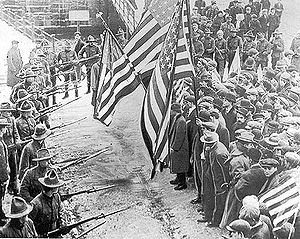
This Day in Labor History: February 26, 1972. A Pittston Coal Company slurry dam collapsed in Logan County, West Virginia. The ensuing flood of coal slurry would kill 125 people and demonstrate once again the contempt the coal industry has for the people of West Virginia! 

Coal slurry is basically the toxic leftovers of modern industrial coal production. This was less of an issue in the days of underground mining, but with strip mining and later mountaintop removal, large scale residue became a real problem.
The coal is sifted and processed, washed of impurities, and transported to market by rail or boat. The leftover is the slurry. It includes heavy metals including arsenic, mercury, beryllium, manganese, selenium, cadmium, as well as a whole slough of toxic chemicals.
This is nasty stuff. The process for cleaning this up was haphazard then and it is now. Basically, coal companies built a dam and dumped it in there mixed with the water that naturally filled up behind the dam.
Pittston was the largest coal company in the United States in the 1970s and its dams had a history of problems. The company began dumping coal waste in the Middle Fork of Buffalo Creek in 1957 and built its first dam to impound the material in 1960.
It built two more dams, each about 600 feet upstream, turning the creek into a series of black pools of polluted water. These were basic impoundments made of earth and not sophisticated dams guaranteed to stand up to harsh weather.
In 1967, the Department of Interior had warned Pittston the dams (along with 29 others in the state) were unstable and dangerous. Pittston executives did not care. The third dam broke in July 1971, but the second dam held the water and disaster was briefly averted.
Pittston also had a long reputation for poor safety practices. It was cited for over 5000 violations at mines in 1971 alone, but only paid $275 of the $1.3 million in fines it was levied.
These impoundments were actually banned by the Federal Coal Mine Health and Safety Act, but had so far been unenforced.
Late February was very rainy in West Virginia. Residents were nervous about the state of the dams. A mere 4 days before the dam collapsed, a federal mine inspector declared the dam safe.
But on the morning of February 26, the third dam caved and this time the second dam did not hold. Neither did the first. A huge wall of polluted water rushed down Buffalo Creek.
When the dam caved, 132 million gallons of slurry entered Buffalo Creek. Downstream lay 16 small towns with a total of 5000 people. 125 would die that day. 1121 were injured 4000 people lost their homes. These little towns were all old coal company towns.
The companies had divested any responsibility for the towns before this, but most the people who lived either worked in coal or had family members in the industry.
Already these towns were dying as mechanization replaced thousands of jobs in the 1950s and people left, largely for the northern industrial factories.
Pittston Coal called the mine collapse “an act of God” in its legal filings, saying the dam couldn’t hold all the water “God poured into it.” As if it was God who constructed unsafe dams and then filled them with coal sludge.
Typically, the state government of West Virginia, wholly owned by the coal industry, “investigated” the dam collapse with a commission made up of wholly pro-coal men.
Governor Arch Moore initially banned reporters from entering the area to prevent “irresponsible reporting,” a tactic that reminded many of the old days when basic constitutional rights and freedoms did not apply in coal country.
A circuit court grand jury refused to indict Pittston or its executives for any of the many laws it broke with the dam collapse.
The special prosecuting attorney, Willard Lorenson of the West Virginia University School of Law, said, “It has been a noble exercise in American justice.”
When the United Mine Workers, now in a period of reform after the corrupt Tony Boyle, a man indifferent to the lives of his own men, was ousted and imprisoned, protested over this sham, the governor ignored them.
So the UMWA created the Citizens Commission, which issued a report calling the coal company guilty of the murder of all 125 dead.
The state followed by suing Pittston for $100 million, but just before leaving office, Moore settled for a mere $1 million, thus ensuring his place as one of the most pro-industry hacks in the history of American politics.
The survivors sued Pittston but received only a pittance of $13,000 a piece after legal costs, or about $61,000 in 2014 dollars. Moore sought to capitalize on the disaster by promising to do something to help the citizens who lost their homes.
He proposed 10 new housing developments for Buffalo Creek, with 750 homes. The total built was 17 homes and 90 apartments, all constructed on top of a coal tailings pile.
Moore also attempted to use federal disaster money to ram a superhighway through the valley. Residents were bought out but only a two-lane road was built.
Moore promised to build a community center with the funds given back to the community by the lawyers for the plaintiffs from their fees. The community center was never built.
In 1975, the great Appalachian film project Appalshop made a film titled “The Buffalo Creek Flood: An Act of Man.” You can watch an 8 minute excerpt here.
In 1990, Arch Moore was sentenced to 5 years in prison for graft after stealing money from the state’s black lung fund. He is the father of Shelley Moore Capito, the senator from West Virginia. Apple doesn't fall far from the tree here.
Back tomorrow to discuss the great fighter for non-toxic workplaces, Alice Hamilton.
• • •
Missing some Tweet in this thread? You can try to
force a refresh







